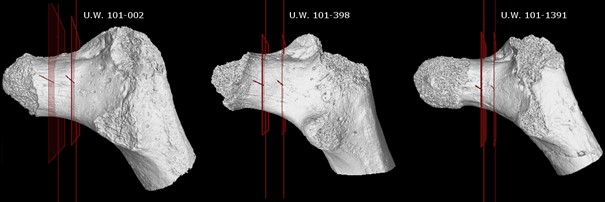EXPLORING THE MOVEMENT HABITS OF HUMAN ANCESTORS

The long bones of the limbs of humans and their evolutionary ancestors are a good source of information about their movement patterns, foraging strategies (subsistence strategies) and interspecific differences. Indeed, long bones are both shape-distinguishable across primate species, but also show a relatively high degree of plasticity and adaptability to mechanical stresses. Therefore, throughout life, their internal structure is reshaped to always balance the mechanical and metabolic demands of the organism. The Department of Anthropology has long been involved in the study of the internal structure of the long bones of limbs of ancestral humans (e.g., Homo naledi and other hominins of southern Africa) and sub-recent human populations (e.g., the Mesolithic people of Sudan), primarily through the distribution of dense bone tissue, but also through the external morphology or structure of the trabecular bone within the articular ends.
DO YOU WANT TO LEARN MORE?
Listen to the Podcast of the UWB Faculty of Arts with Lukáš Friedl.
CONTACT OUR RESEARCHERS
WRITTEN ABOUT US
„Nález člověka hvězdného? V jeskyni je toho ještě mnohem víc, říká člen výzkumného týmu“ (“Finding Homo Naledi? There's more to the cave, says research team member“), DVTV Interview , 17 September 2015
„Inteligence je mnohem starší, než jsme si mysleli“ (“Intelligence is much older than we thought“), Respekt – Zkumavka, 18 June 2017
„Mrtvé pohřbívali už dávní lidé, u nichž se to považovalo za nemožné. V čem je objev zlomový?” (“The dead were buried by ancient people who were considered incapable. How is the discovery groundbreaking”), Deník N, 14 June 2023